1 What Is International Agriculture and Development?
Joseph Cho
Learning Objectives
Agriculture happens all around the globe. This chapter explores what international agriculture is and why it is an essential part of our interconnected world. This chapter also discusses international development and the theories that are associated with it. At the end of the chapter, students will be able to:
- Define food security.
- Define international agriculture.
- Define development in the international context.
- Identify the three development theories related to agriculture.
Definitions
In order to understand international agriculture, we must first come to an agreement on the definition of agriculture. One definition is a “program that focuses on the application of agricultural management and scientific principles to the problems of global food production and distribution, and to the study of the agricultural systems of other countries” (National Center for Educational Statistics [NCES], n.d.). If the traditional definition of agriculture focused exclusively on farming and cultivation, the definition has since been broadened to signify a multidisciplinary field that includes but is not limited to individuals working in archaeology, anthropology, biogeography, genetics, linguistics, and taxonomy (Harris & Fuller, 2014).
With this in mind, the term “international agriculture” can subsequently be defined as agriculture that occurs between countries. This definition is flexible and broad enough to provide answers to a plethora of questions related to society, which is comprised of “farms, rural people, and [the] environment” among other elements (Offutt, 2002). For the sake of consistency throughout this chapter, we consider international agriculture to be a field that is diverse and interconnected and that goes beyond the scope of a single cultural lens.
The terms “multidisciplinary,” “interdisciplinary,” and “transdisciplinary” might be new to you. These terms signify more than one discipline working to achieve a specific goal. The three terms can be viewed as part of a continuum representing varying levels of collaboration (Choi & Pak, 2006). Multidisciplinary work is when individuals from two or more disciplines come together with limited interaction (Grossman, 1979, as cited in Choi & Pak, 2006). Interdisciplinary work involves interactions across disciplines, but individuals do not cross over to one another’s disciplines (Bernard-Bonnin et al., 1995). Transdisciplinary work is when individuals from different disciplines work together to create a new concept that fits the mold of the represented discipline (Rosenfield, 1992). International agriculture and development work is a notable example of interdisciplinary work because it relies on the input of individuals from different disciplines who come together to work on a specific project without creating a new theory or area of study. Depending on the specific work, however, international agriculture and development may sometimes be considered multidisciplinary or transdisciplinary work. Choi and Pak (2006) describe the multidisciplinary as additive, the interdisciplinary as interactive, and the transdisciplinary as holistic.
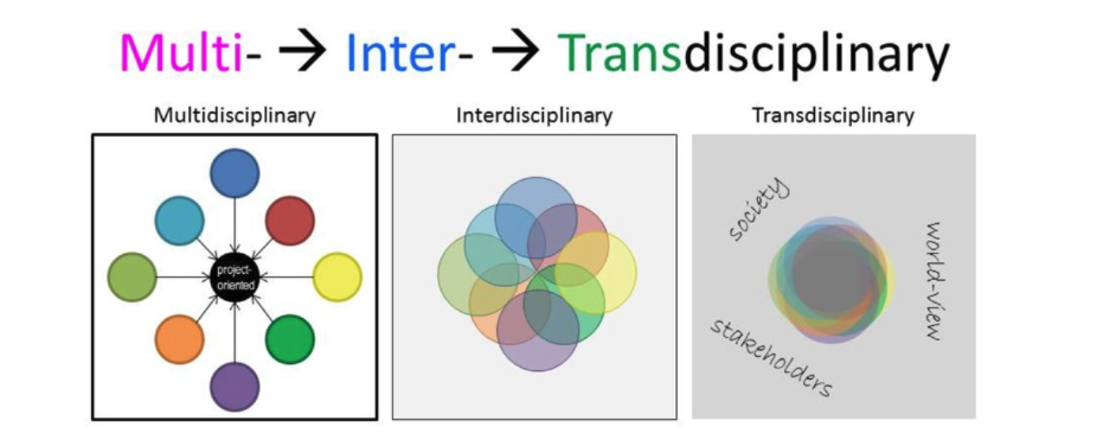
International Agriculture
Diversity of International Agriculture
Imagine a farm. Think about the details of the farm. Does it have livestock, crops, and a farmer? What are the soil, landscape, geography, water, and air around the farm like? How about the community and environmental aspects that affect the farm? The image of the farm that you have in your mind is likely different from your neighbor’s. That is because there are many different farms with different purposes and goals. According to Dixon et al. (2001), there are eight broad categories of farming systems around the world (Table 1).
Table 1 Farming systems
| Farming system | Description |
|---|---|
| Irrigated farming systems | Embraces a broad range of food and cash crop production |
| Wetlands rice-based farming systems | Depends on seasonal rains supplemented by irritation |
| Rainfed farming systems in humid areas | Characterized by specific dominant crops or mixed crop–livestock systems |
| Rainfed farming systems in steep and highland areas | Often characterized by mixed crop–livestock systems |
| Rainfed farming systems in dry or cold low-potential areas | Merges mixed crop–livestock and pastoral systems into systems with very low current productivity or potential because of extreme aridity or cold |
| Dualistic (mixed large commercial and smallholder) farming systems | Exist across a variety of ecologies and with diverse production patterns |
| Coastal artisanal fishing systems | Often incorporate mixed farming elements |
| Urban-based farming systems | Typically focused on horticultural and livestock production |
Note: Based on Dixon et al. (2001), Farming systems and poverty: Improving farmers’ livelihoods in a changing world. Food and Agriculture Organization of the United Nations.
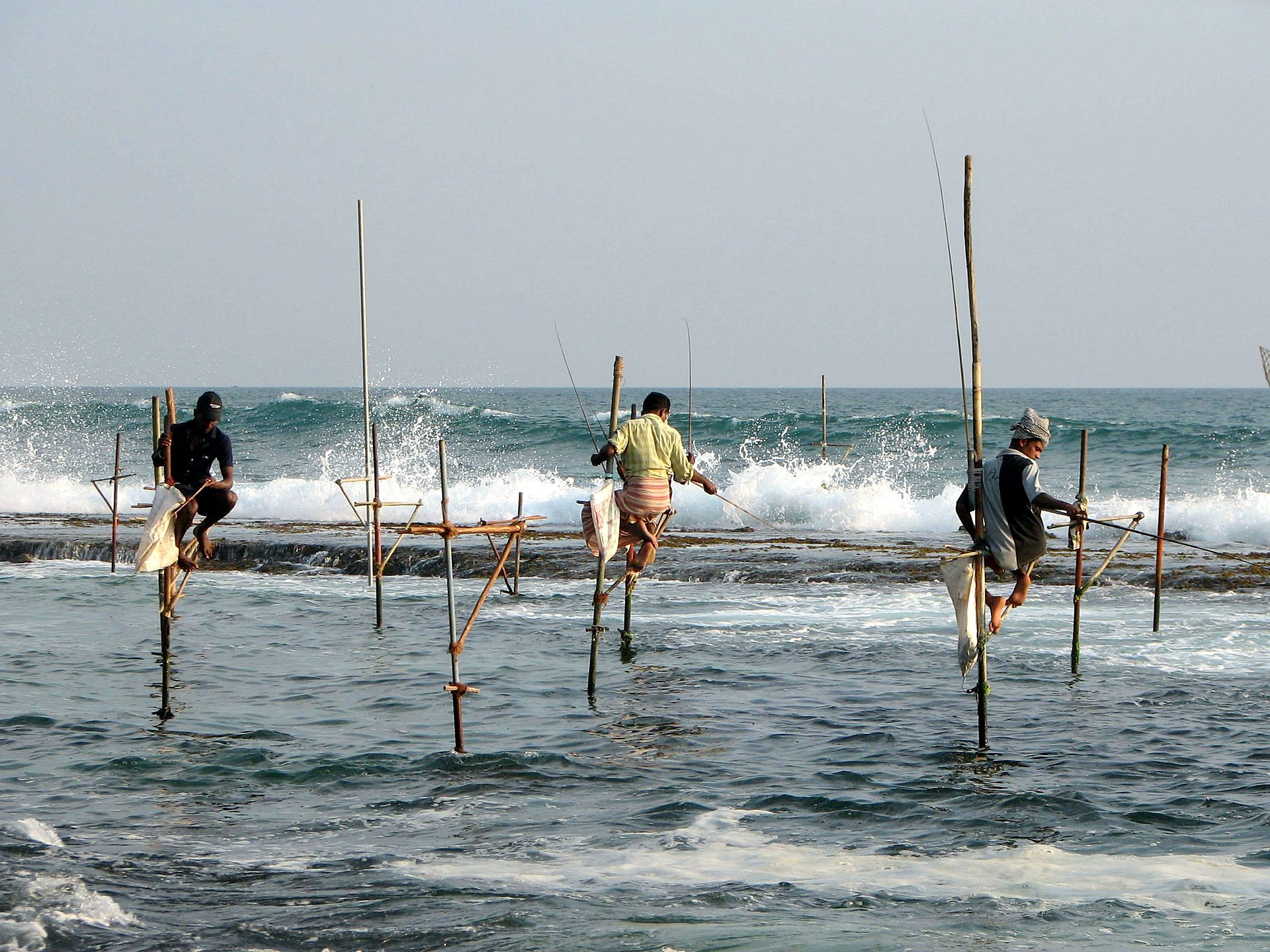

As seen in Table 1, there are different categories of farming systems with different purposes and different locations. However, agriculture is more than just farming. In fact, international agriculture is an interdisciplinary field that draws from both the natural and social sciences, making it diverse in many different dimensions. Each of the chapters in this book discusses a different area of agriculture such as trade and policy (Chapter 2); soil (Chapter 3); water (Chapter 4); biodiversity and conservation (Chapter 5); gender, agriculture, and development (Chapter 6); family farming (Chapter 7); labor in agriculture (Chapter 8); health (Chapter 9); genetically modified organisms (Chapter 10); and global extension (Chapter 11). All of these components are interconnected, and that is why international agriculture is considered an interdisciplinary field.
Importance of Development
You may wonder what development has to do with international agriculture. First, let’s define development. According to Reyes (2001), development is “a social condition within a nation, in which the authentic needs of its population are satisfied by the rational and sustainable use of natural resources and systems” (p. 109). Reyes offers a broad definition of “needs” that includes “education, housing, health services, and nutrition” as well as the right to preserve culture and tradition within the social framework of a country (p. 109). International agriculture is a field that has worked to help those countries that are in need of developing to meet their goals. Examples of the relationship between international agriculture and development are seen in the United Nations’ Millennium Development Goals and Sustainable Development Goals.
Millennium Development Goals and Sustainable Development Goals
In 2000, the United Nations (UN) and its member states proposed a set of eight goals called the Millennium Development Goals (MDGs). The MDGs were intended to be the blueprint to help developing countries modernize. The eight MDGs were intended to
- eradicate extreme poverty and hunger;
- achieve universal primary education;
- promote gender equality and empower women;
- reduce child mortality;
- improve maternal health;
- combat HIV/AIDS, malaria and other diseases;
- ensure environmental sustainability; and
- form a global partnership for development (United Nations [UN], n.d.a).
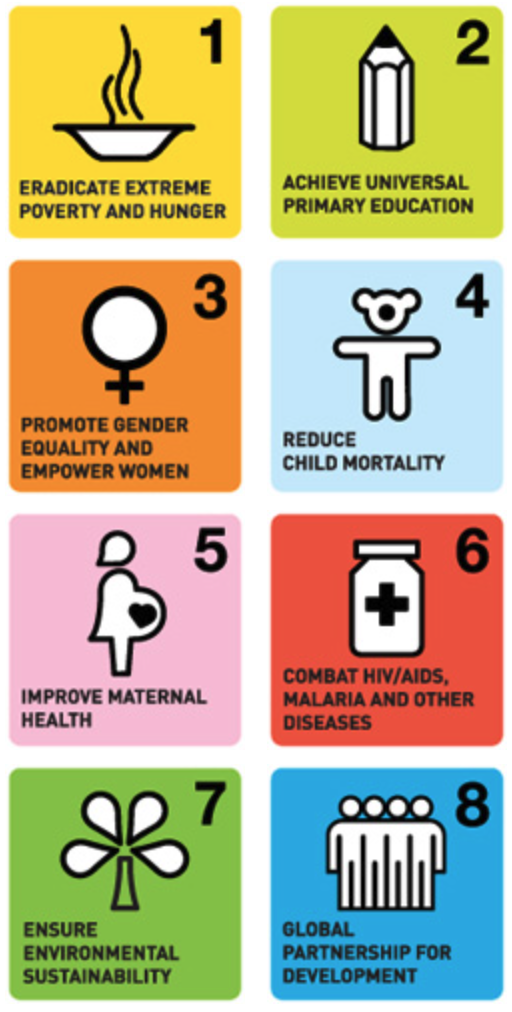
The UN and the member states proposed achieving the MDGs by 2015. However, the goals were not met and a new set of goals and a new deadline to achieve the goals had to be established. These new goals, titled the Sustainable Development Goals (SDGs), had a 15-year target date. Unlike the MDGs, the SDGs were intended to help solve the issues and challenges that every country faces (UN, n.d.b). In particular, the 16 SDGs seek to
- end poverty in all its forms everywhere;
- end hunger, achieve food security and improve nutrition and promote sustainable agriculture;
- ensure healthy lives and promote well-being for all at all ages;
- ensure inclusive and equitable quality education and promote lifelong learning opportunities for all;
- achieve gender equality and empower all women and girls;
- ensure availability and sustainable management of water and sanitation for all;
- ensure access to affordable, reliable, sustainable and modern energy for all;
- promote sustained, inclusive and sustainable economic growth, full and productive employment and decent work for all;
- build resilient infrastructure, promote inclusive and sustainable industrialization and foster innovation;
- reduce inequality within and among countries;
- make cities and human settlements inclusive, safe, resilient, and sustainable;
- ensure sustainable consumption and production patterns;
- take urgent action to compact climate change and its impacts;
- conserve and sustainably use the oceans, seas and marine resources for sustainable development;
- protect, restore and promote sustainable use of terrestrial ecosystems, sustainably manage forests, combat desertification, and halt reverse land degradation and halt biodiversity loss;
- promote peaceful and inclusive societies for sustainable development, provide access to justice for all and build effective, accountable and inclusive institutions at all level; and
- strengthen the means of implementation and revitalize the global partnership for sustainable development (UN, n.d.b).

Click here to view how the United States and other countries are doing in terms of meeting the SDGs.
Theories Related to Development
There are many perspectives and theories on what development is and how it happens. This section presents three development theories that are widely known. The three theories are the theory of modernization, the theory of dependency, and the theory of globalization.
Modernization Theory
Modernization theory is one of the oldest approaches to development. It focuses on the transformation of a country’s traditional and rural societies to modern and urban societies (Srubar, 2001). According to the theory, modern societies are superior to nonmodern societies in terms of production, education, and welfare, among other characteristics (Smelser, 1967). Modernization is viewed as a homogenizing process in which, according to Levey (1967), “as time goes on, they [developing countries] and we [developed countries] will increasingly resemble one another because the patterns of modernization are such that the more highly modernized society become, the more they resemble one another” (p. 207). The progress or modernization of a developing country is considered inevitable. The time it takes for a developing country to become a developed nation is substantial since according to the theory, modernization is an evolution rather than a revolution (Huntington, 1971).
Modernization theory has mainly been applied in the field of economics. Rostow’s (1959) five stages of economic growth presents development as a linear process. The five stages of development are (1) traditional society, (2) the preconditions for take-off, (3) the take-off, (4) the drive to maturity, and (5) the age of high mass consumption. This model can be used to assess the current stage of a particular developing country and the supplemental help the country needs to move closer to modernization.
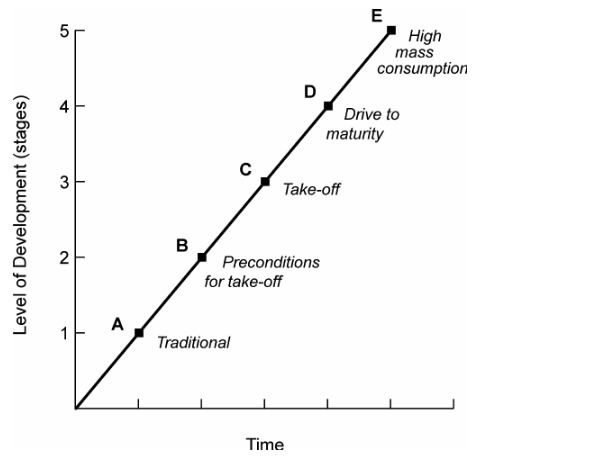
Although modernization theory was the foundation of many development theories in the 1950s, it has been criticized for a couple of reasons. First, many scholars have commented that the development process or development itself is not necessarily a unidirectional linear process as Rostow argues. Second, the theory is based on Western knowledge derived mainly from the United State and European nations. While this homogenous model might have helped Rostow theorize and understand the process by which Western countries developed, it does not reflect the contextual and situational aspects of developing countries in other parts of the world. In fact, the development of countries such as Japan and South Korea has been drastically different than that of Western countries (Killing, 1984, as cited in Reyes, 2001; Redfield, 1965, as cited in Reyes, 2001).
Dependency Theory
Dependency theory was established with the goal of understanding why economic development in developed countries does not translate to the same development in developing countries. The theory identifies a relationship between developing countries, or peripheral nations, and developed countries, or core nations. According to Ferraro (2008), peripheral nations export raw natural resources to core nations where the resources are then manufactured into products. The products are then sold back to the peripheral nations at a higher price than the price for which the resources were initially sold. The model below shows the interaction between peripheral and core nations. The theory suggests the activities in developed countries hinder the development of developing countries.
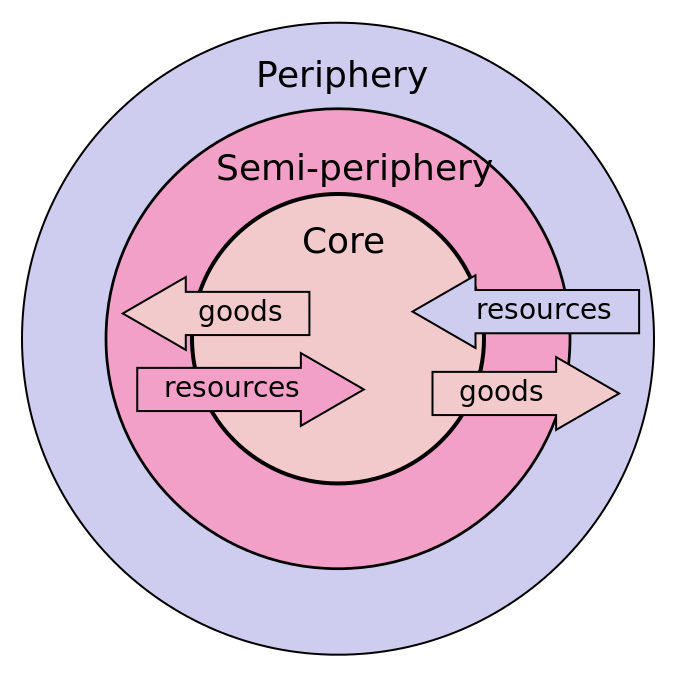
Prebisch wanted to help developing countries acquire some of the characteristics that had helped developed countries to become developed. However, according to Ferraro (2008), there are three issues that make it difficult to establish crucial policies to help peripheral nations. First, the domestic market of a developing country generally does not have the capacity and the ability to keep commodities and products at reduced prices. Second, the governing body and the political will of a developing country are considered weak and it is doubtful whether such a country can be a primary product producer. Lastly, the capacity or the power of the developing country to control its products, especially abroad, is also doubtful.
Dependency theory is one way of viewing the globalized world. It does not, however, explain why developing countries are struggling with poverty. There is still not enough empirical evidence to fully support the conclusions of dependency theory. Another flaw of dependency theory is that it focuses on the issue of transnational corporations, whereas there are other reasons why poverty is widespread in many developing countries (Dos Santos, 1970).
Globalization Theory
Globalization theory emphasizes the interconnectedness of the world through production, communication, and technology rather than economics, finance, and politics (Kaplin, 1978, as cited in Reyes, 2001). Globalization theory can be summarized into three points. First, cultural factors dictate societal aspects. Second, the domestic unit of analysis (nation to state) is becoming less relevant while global relationships are becoming more relevant. Lastly, technological advancement has helped foster interconnectivity since members of different social, national, and ethnical groups can connect with each other easily (Reyes, 2001).
The key emphasis of globalization theory is the cultural variable. The cultural variable affects the social, economic, and political variables of nations. This also includes the connection aspect in which one aspect of a culture is borrowed or replicated from another culture. Meyers (2007) states that the “copying of fashionable institutions and policies” (p. 263) is one of the effects of the globalization model and thus concludes that not only do leading nations influence the national and local policies of other nations, but they also exhibit good citizenship and help set a global standard.
Conclusion
This book provides a strong foundation for you as you begin to learn about and understand international agriculture. This chapter began by explaining and defining international agriculture. International agriculture is a broad and expansive discipline that encompasses fields that are both diverse and interconnected. It cannot be viewed from one particular cultural lens. Development is a big part of international agriculture. Development is defined as a process or a condition that satisfies the basic needs of people. The needs include education, housing, healthcare services, and nutrition, which are part of the UN’s SDGs. There are also different views on development. In this chapter, three popular theories were described: modernization theory, dependency theory, and globalization theory. The last part of the chapter talked about a group called GCUA that is helping to develop international collaboration among different disciplines and fields to solve global issues.
This chapter laid the foundation for learning about international agriculture and development by defining and identifying basic terminology and concepts that recur throughout the rest of this book. However, the focus of Chapter 1 was not only to help you learn basic terminology and concepts but also to capture for you the important roles international agriculture and development play in the world today.
References
Choi, B. C. K., & Pak, A. W. P. (2006). Multidisciplinarity, interdisciplinarity and transdisciplinarity in health research, services, education and policy: Definitions, objectives, and evidence of effectiveness. Clinical and Investigative Medicine, 29(6), 351–364. https://doi.org/10.25011/cim.v30i6.2950
Dixon, J. A., Gibbon, D. P., & Gulliver, A. (2001). Farming systems and poverty: Improving farmers’ livelihoods in a changing world. Food and Agriculture Organization of the United Nations.
Dos Santos, T. (1970). The structure of dependence. American Economic Review, 60(2), 231–236. https://www.jstor.org/stable/1815811
Ferraro, V. (2008). Dependency theory: An introduction. In G. Secondi (Ed.), The development economics reader (pp. 58–64). Routledge.
Gilbert, D. J., Hld, M. L., Ellzey, J. L., Bailey, W. T., & Young, L. B. (2014). Teaching “community engagement” in engineering education for international development: Integration of an interdisciplinary social work curriculum. European Journal of Engineering Education, 40(3), 256–266. https://doi.org/10.1080/03043797.2014.944103
Harris, D. R., & Fuller, D. Q. (2014). Agriculture: Definition and overview. Encyclopedia of Global Archaeology, 104–113. https://doi.org/10.1007/978-1-4419-0465-2_64.
Huntington, S. P. (1971). The change to change: Modernization, development and politics. Comparative Politics, 3(3), 283–322. https://doi.org/10.2307/421470
Klein, J. T. (1990). Interdisciplinarity: History, theory, and practice. Wayne State University Press.
Levey, M. (1967). Social patterns and problems of modernization. Prentice-Hall.
Meyer, J. W. (2007). Globalization: Theory and trends. International Journal of Comparative Sociology, 48(4), 261–273. https://doi.org/10.1177/0020715207079529
National Center for Educational Statistics. (n.d.).Classification of instructional programs. Agriculture, General. https://nces.ed.gov/ipeds/cipcode/cipdetail.aspx?y=55&cipid=87742
Offutt, S. (2002). What is agriculture? In Conference on Agricultural and Environmental Statistical Applications in Rome (CAESAR 2001).
Reyes, G. E. (2001). Four main theories of development: Modernization, dependency, word-system, and globalization. Nómadas: Revista Crítica de Ciencias Sociales y Jurídicas, 4(2), 109–124.
Rosenfield, P. L. (1992). The potential of transdisciplinary research for sustaining and extending linkages between the health and social sciences. Social Science & Medicine, 35(11), 1343–1357. https://doi.org/10.1016/0277-9536(92)90038-r
Rostow, W. W. (1959). The stages of economic growth. Economic History Review, 12(1), 1–16. https://doi.org/10.1111/j.1468-0289.1959.tb01829.x
Smelser, N. J. (1967). Toward a theory of modernization. Natural History Press.
Srubar, I. (2001). Science and development. In N. J. Smelser & P. B. Baltes (Eds.), International encyclopedia of the social and behavioral sciences. (pp. 13607–13610). Elsevier Science.
United Nations. (n.d.a). Millennium Development Goals and beyond 2015. https://www.un.org/millenniumgoals/
United Nations. (n.d.b). The 17 goals. https://sdgs.un.org/goals
Waage, J., Cornelsen, L., Dangour A. D., Green R., Häsler, B., Hull, E., Johnston, D., Kadiyala, S., Lock, K., Shankar, B., Smith, R. D., & Walls, H. L. (2019). Integrating agriculture and health research for development: LCIRAH as an interdisciplinary programme to address a global challenge. Global Challenges, 3(4), 1–12. https://doi.org/10.1002/gch2.201700104

